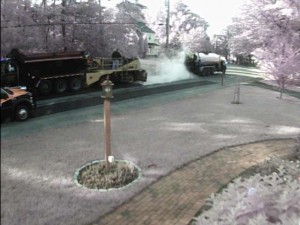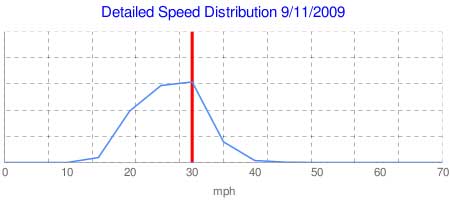Sat 12 Sep 2009
Rumble Strips
Posted by Christian Donner under Community , Traffic and SafetyComments Off on Rumble Strips
Several Medfield roads have recently been resurfaced using the infamous “oil and chip” technique, sometimes also referred to as “tar and chip”, “chip seal”, or “seal coat”. An asphalt/oil/polymer emulsion is spread on the substrate (usually the existing, but cracked and worn asphalt surface), and then loose aggregate is applied on top of the “oil”. The aggregate is then rolled into the “oil”. The idea is that the “oil” will bind with the aggregate and form a durable top layer that protects the road and slows further erosion of the surface. The “oil” and the aggregate are made from the same materials as regular blacktop (tar and stone).

"Oil and chip" process applied on Green Street
This technology offers rather substantial cost savings over conventional road surfacing technologies (by an order of magnitude), and this may be an incentive to not wanting to know about any issues that come with it.
There is excess aggregate material on the surface after the application that does not bind with the “oil” and has to be removed. Until this is done, the condition of such a road is dangerous for cars, because the reduced traction increases the time and distance it takes to come to a stop, and because the loose material gets flung into the air by speeding vehicles and can damage the paint and the windshield. Such a road is particularly dangerous for motorcycles and bicycles (for obvious reasons). Pedestrians should wear protective eye glasses when walking on the sidewalk of such a road, because aggregate chips get flung into the air by speeding vehicles and can cause serious injuries.
Green Street was one of the roads treated with this technology. Because of these hazards, it would be important to impose and enforce temporary speed limits with proper signage. Unfortunately, this did not happen, and not even the normal speed limit is being enforced. Many drivers on Green Street appear to be unaware or ignorant of these hazards.
On 9/11/2009, day 1 after the application, the average speed was 28 mph (on normal days it is between 30 mph and 35 mph), but there are still vehicles travelling at speeds well above 40 mph, sending the gravel flying and creating large clouds of dust. The expression on the drivers’ faces conveys a sense of entitlement.
Unfortunately for many Medfield residents, the increase in tire noise of a road surface treated with oil and chip technology is substantial. People who complain about increased noise pollution on oil and chip roads are customarily being told that the noise will abate as the aggregate wears off. Reality tells a different story. Emerson Road in Medfield was treated with the technique in 2008 and is still as noisy a year later. Pine Street and many other roads were turned into rumble strips years ago, and still rumble. Cars are roaring by as the author types these lines. This is what living on Rt. 128 must sound …
Keep the kids in the house, doors and windows batted down, and wear ear plugs!
A quote from the website of the European Federation for Transport and Environment:
Whilst low noise surfaces are comparatively expensive to apply and maintain, the costs must be considered in comparison with the total benefits of reducing traffic noise in terms of money saved on unsightly noise barriers, building insulation, health costs and property values. The use of low noise surfaces should clearly be prioritized, and targeted on the busiest roads in densely populated areas.
A quote from a University of Florida University Transportation Technology Transfer Center publication:
While chip seals are very effective at preventing moisture penetration and further oxidation of the existing road surface, public perception can create problems. Because of the appearance and reality of loose aggregate after construction, the application is not recommended for urban residential areas. Citizens often complain of cracked windshields or rough texture and confuse the process with gravel roads – one of the primary reasons the process is used sparingly in more highly populated areas in Florida.
All things considered, including the health of residents, potential liability suits and legal costs, damage to vehicles, injuries and hospitalization cost, and the decline in property values, doing road repairs on the cheap is probably an expensive proposition, even though the true costs don’t show up on the town’s balance sheet.
Other Web Links:
Pittsburgh Post-Gazette: Low-tech tar and chip road repairs rile drivers
Car Talk discussion thread: Gravel vs Repaving
Edgar Snyder & Associates Law Firm: Hazardous Road Conditions
Morgan & Morgan Law Offices: Motorcycle Road Hazards

